If you’ve ever visited the Hawaiian Islands, chances are you’ve heard a rooster crowing from a palm tree or watched a hen and her chicks strutting confidently across a parking lot. Hawaii’s feral chickens have become a signature part of the islands’ landscape — noisy, colorful, and impossible to ignore. What many visitors don’t realize, however, is that these free-roaming birds are not all the same. They belong to different lineages, from ancient Polynesian junglefowl to modern domestic hybrids that escaped during storms.
Over centuries, these birds have adapted to Hawaii’s unique climate and ecosystems, forming distinct populations across different islands. Today, Hawaii is home to several recognizable types of feral chickens — each with unique ancestry, appearance, and behavior.
In this guide, we’ll explore the five main types of feral chickens in Hawaii, complete with their identification features, size, coloration, habitat preferences, and island distributions. Whether you’re a curious traveler, a birdwatcher, or a resident tired of 4 a.m. crowing, this detailed overview will help you understand these fascinating feathered islanders.
Polynesian Red Junglefowl (Moa)
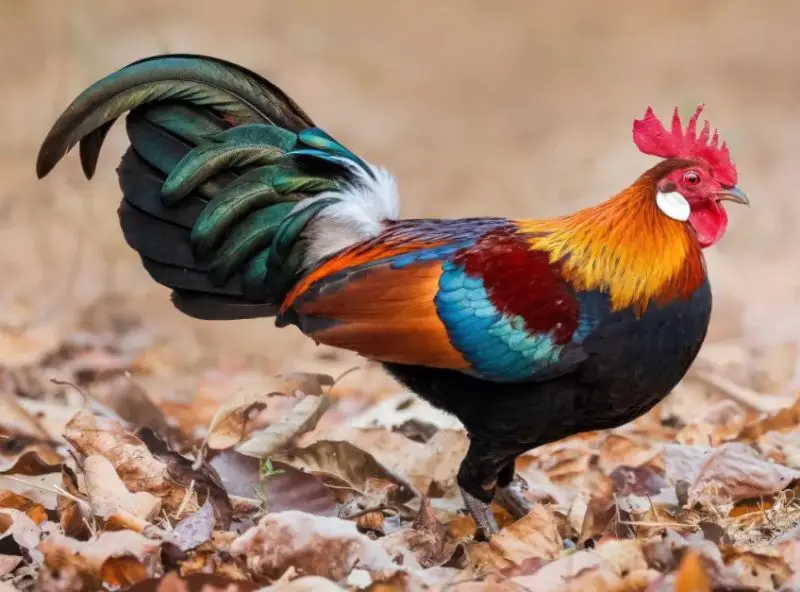
Identification and Characteristics
The Polynesian Red Junglefowl, locally called moa, is the earliest ancestor of Hawaii’s feral chickens. These birds were brought to the islands by Polynesian voyagers over 800 years ago, long before European contact. They closely resemble their wild relatives in Southeast Asia, the Red Junglefowl (Gallus gallus) — the original species from which all domestic chickens descended.
Males are strikingly beautiful, displaying shimmering red-orange plumage, iridescent green-black tail feathers, and a bright red comb. Females are smaller and more subdued, with brown or cinnamon plumage that helps them blend into vegetation. Adult males typically weigh 2–3 pounds, while females average 1.5–2 pounds.
Behavior and Habitat
True junglefowl behavior remains evident in these birds. They are extremely wary, quick to flee at the first sign of movement, and spend much of their day scratching for seeds and insects under forest canopies. At night, they roost high in trees, away from predators.
These birds thrive in lightly wooded forests, coastal thickets, and agricultural edges. Unlike the bolder urban hybrids, Polynesian junglefowl are most often found in remote areas of Kauaʻi and Oʻahu, where native forest still dominates.
Distribution in Hawaii
Populations of near-pure Polynesian Red Junglefowl are believed to persist mostly on Kauaʻi, thanks to the island’s lack of mongooses, which are a major chicken predator on other islands. Genetic studies have shown that Kauaʻi’s feral chickens retain more junglefowl DNA than any other Hawaiian population, making them a living link to Hawaii’s ancient past.
Kauaʻi Feral Chicken (Hybrid Junglefowl)
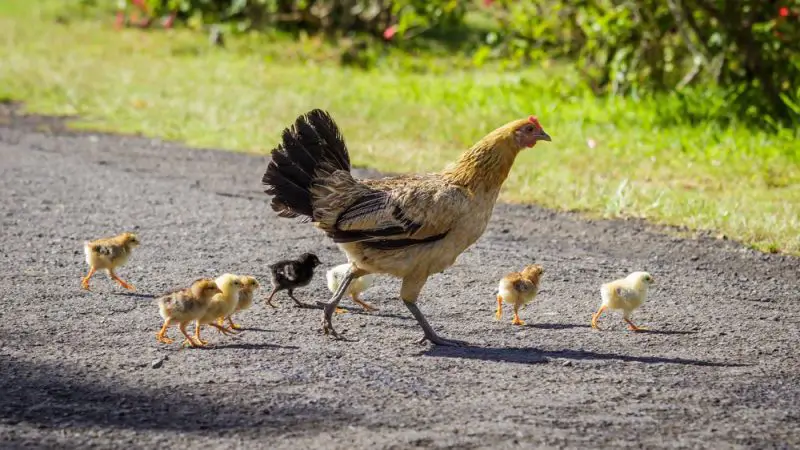
Identification and Appearance
The Kauaʻi Feral Chicken is perhaps the most famous bird in all of Hawaii. These hybrid chickens are the result of centuries of interbreeding between the Polynesian Red Junglefowl and modern domestic chickens that escaped during hurricanes Iwa (1982) and Iniki (1992).
Their appearance varies widely, but most retain the wild-type junglefowl look: bright red combs, golden neck feathers, and long, iridescent green-black tails. However, some individuals exhibit domestic traits — white patches, barred feathers, or bulkier bodies. Males average 3–4 pounds, and females around 2–3 pounds, slightly larger than their pure junglefowl ancestors.
Behavior and Adaptation
Kauaʻi’s feral chickens are famous for their confidence and adaptability. They can be seen foraging in open grasslands, city streets, beaches, and even resort gardens. They eat seeds, insects, fruit, and discarded human food. Their ability to exploit human environments gives them a survival advantage unmatched by native birds.
Unlike most birds, Kauaʻi chickens are diurnal and highly vocal, crowing at any time of day. Hens nest in sheltered spots such as under ferns or bushes, often laying 6–12 eggs at a time.
Habitat and Distribution
These chickens are found everywhere on Kauaʻi, from the tropical rainforests of Hanalei to the dry coastal cliffs of Poʻipū. Because Kauaʻi has no mongooses, their numbers have exploded, forming one of the densest feral bird populations in the Pacific. For visitors, their presence is both charming and chaotic — a true symbol of Kauaʻi’s wild side.
Hawaiian Gamefowl Hybrids
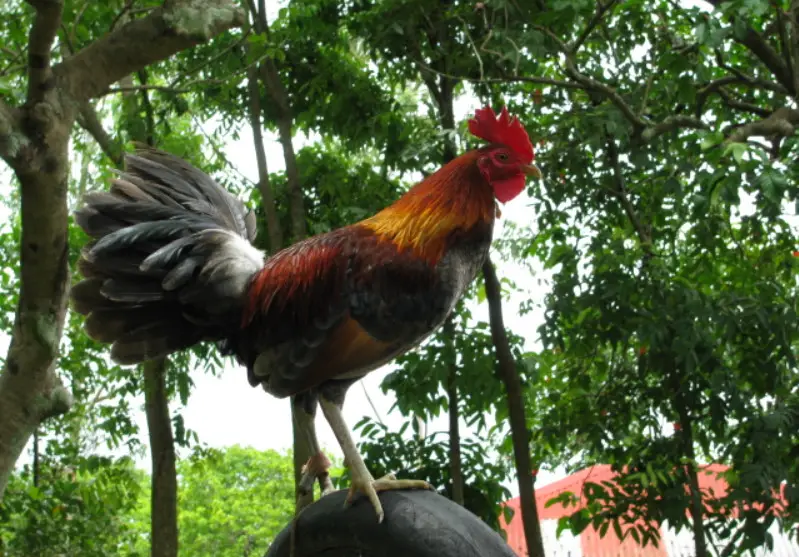
Origin and Identification
The Hawaiian Gamefowl Hybrid population descends from fighting roosters and game breeds once raised for cockfighting, a practice historically present across the islands. When these birds escaped or were released, they interbred with existing feral flocks, creating strong, muscular hybrids with aggressive temperaments.
These birds are medium to large in size, weighing 4–6 pounds for males. They exhibit striking coloration: deep maroon necks, dark green tail feathers, and metallic sheens. Their legs are long, their bodies lean, and their combs often smaller than those of domestic chickens.
Behavior and Temperament
Hawaiian gamefowl hybrids are territorial and alert, often seen alone or in small groups rather than large flocks. Males defend territories vigorously, engaging in short but intense fights to establish dominance. Their survival instincts are sharp, making them excellent foragers that can thrive in both open fields and rugged terrain.
They prefer rural and agricultural landscapes, where cover and food sources are abundant. Unlike the urban Kauaʻi chickens, gamefowl hybrids are more common in Oʻahu’s rural districts, Maui’s farms, and Big Island’s upland areas.
Distribution in Hawaii
These hybrids are scattered across multiple islands but are especially prominent in Oʻahu’s Waianae region, Maui’s interior valleys, and Puna District on Hawaiʻi Island. Though less numerous than Kauaʻi’s hybrids, they contribute to Hawaii’s remarkable feral chicken diversity.
Modern Domestic Escapees
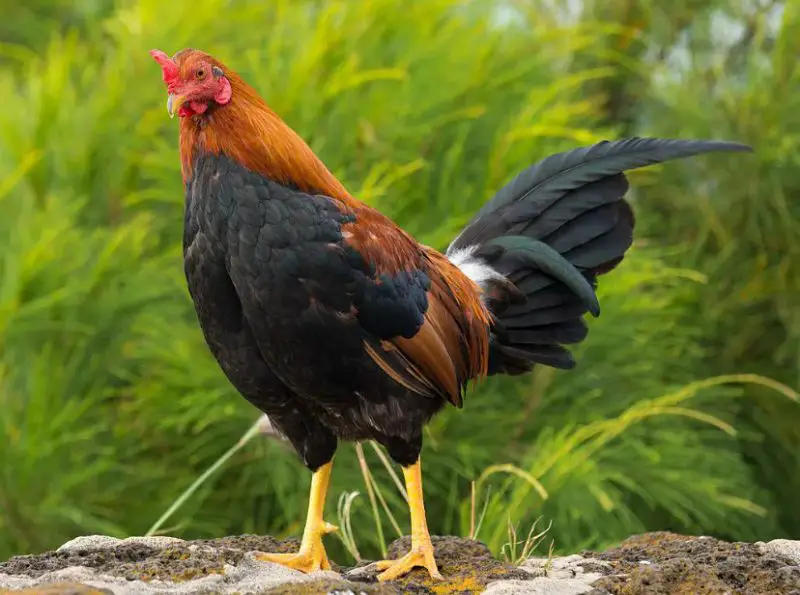
Appearance and Traits
Modern domestic escapees are chickens that recently broke free from backyards or small farms and joined wild flocks. Their lineage includes common domestic breeds like Rhode Island Reds, Leghorns, Barred Rocks, and Silkies.
These birds are easy to recognize by their larger body size, rounder shape, and distinct coloration — often white, buff, or patterned rather than the natural junglefowl hues. Adult males may weigh 5–7 pounds, while females can reach 4–5 pounds. Their heavier bodies make them less agile flyers but excellent ground foragers.
Behavior and Habitat
Domestic escapees adapt quickly to Hawaii’s tropical environment. They feed on fallen fruit, insects, and seeds, and sometimes scavenge near human settlements. While they lack the flight ability of junglefowl, they compensate with boldness, often walking openly in parks, parking lots, and residential areas.
Because they originated from farm and backyard settings, these birds are less wary of humans. They may approach people for food, especially in Honolulu, Lahaina, and Hilo. However, they are still fully feral — reproducing, nesting, and raising chicks without human care.
Distribution in Hawaii
Modern domestic escapees are widespread but most common on Oʻahu and Maui, where human population density is highest. Small feral groups have been reported near Honolulu, Kailua, Lahaina, and Wailuku. Over time, these birds often hybridize with wild-type junglefowl, adding to Hawaii’s complex feral gene pool.
Island-Specific Feral Populations
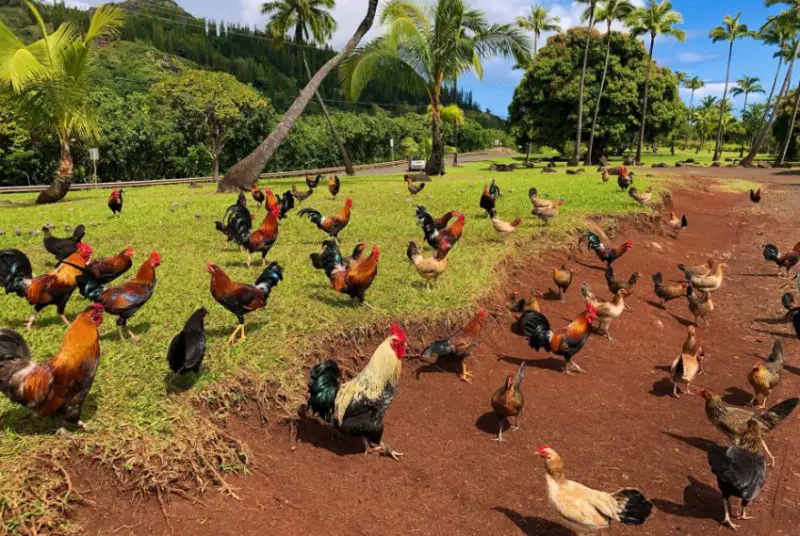
Variation and Genetics
Each Hawaiian island supports its own distinct feral chicken population shaped by geography, predators, and human influence. While they share a common ancestry, their appearance, size, and behavior differ based on local conditions.
On Kauaʻi, feral chickens are abundant, colorful, and bold. The absence of mongooses allows them to thrive in both rural and urban zones. On Oʻahu, populations are more urbanized, often living near neighborhoods and public parks but facing threats from predators and animal control. Maui’s flocks are smaller and more rural, often hiding near farmlands or forest edges. The Big Island hosts fewer chickens overall because its mongoose population keeps them in check.
Appearance and Behavior
Island-specific flocks exhibit a wide range of color variations. Kauaʻi birds retain more wild traits, while Oʻahu and Maui birds show more domestic influence. Their behavior mirrors this genetic diversity — Kauaʻi chickens are fearless, Oʻahu’s are semi-wild but accustomed to humans, and Big Island birds are more elusive.
Feral chickens in all islands, however, share certain habits: they are omnivorous, diurnal, and opportunistic feeders. They build nests on the ground, often concealed by tall grass or bushes, and may raise multiple broods per year due to Hawaii’s mild climate.
Ecological Role
Although often seen as a nuisance, Hawaii’s feral chickens play an interesting ecological role. They help control insect populations, spread seeds, and aerate soil while foraging. However, in high numbers, they can disrupt native ecosystems by competing with native birds or disturbing sensitive vegetation.
Feral Chicken Behavior and Adaptation Across Hawaii
Feral chickens in Hawaii have adapted brilliantly to the islands’ ecosystems. They are highly opportunistic omnivores, eating anything from native fruits and seeds to human leftovers. Their flexible diet allows them to survive in nearly every environment — coastal dunes, tropical forests, and even busy town centers.
One of their most distinctive behaviors is tree roosting. To avoid predators such as cats, dogs, and mongooses, they fly into trees at sunset, sleeping on branches several feet above ground. This behavior comes directly from their junglefowl ancestry and remains crucial to their survival.
Their reproductive rate is impressive — hens can produce multiple clutches a year, each containing 6–12 eggs. Chicks grow quickly, becoming self-sufficient in just a few weeks. Because Hawaii’s climate is warm year-round, there’s no true breeding season; reproduction happens continuously.
Socially, feral chickens maintain a hierarchical structure with dominant roosters controlling small flocks of hens. They communicate through a range of calls, from warning clucks to loud territorial crows that echo through the mornings — and sometimes all day long.
Where to See Feral Chickens in Hawaii
Visitors can encounter feral chickens across nearly all the Hawaiian Islands, but Kauaʻi stands out as the absolute hotspot. In towns like Līhuʻe, Hanalei, and Poʻipū, chickens freely roam parking lots, beaches, and roadsides.
Oʻahu offers sightings around Honolulu, North Shore, and Waimānalo, though the populations are patchier due to predator pressure. On Maui, they can often be seen near Lahaina, Kahului, and Haleakalā foothills, while Big Island chickens are more elusive, found mainly in Puna and Kona districts.
The birds’ adaptability makes them visible nearly everywhere — a testament to how successfully they’ve claimed Hawaii’s landscapes as their own.
Why Are Feral Chickens So Common in Hawaii?
The abundance of feral chickens in Hawaii stems from a perfect storm of historical, environmental, and biological factors. Polynesian settlers first introduced junglefowl centuries ago. Later, European and Asian immigrants brought domestic chickens for food and eggs. When Hurricanes Iwa (1982) and Iniki (1992) struck, they destroyed coops and released thousands of birds into the wild.
The warm, predator-scarce islands provided ideal breeding conditions. On Kauaʻi, the absence of mongooses allowed populations to explode. Without severe winters, the chickens breed year-round, quickly replacing any losses from natural causes.
Human feeding also contributes to their success. Tourists and locals often toss food scraps, unknowingly sustaining urban flocks. This combination of ancient lineage, modern escapees, and perfect conditions made Hawaii a paradise for feral chickens.
FAQs About Feral Chickens in Hawaii
Are Hawaiian feral chickens protected?
Feral chickens in Hawaii are not officially protected under state law, but they are considered public wildlife. Local ordinances vary by island, and removal efforts are often controversial due to cultural and tourism considerations.
Can you eat feral chickens in Hawaii?
Technically, yes — but it’s not common. Feral chickens are tough and gamey compared to farm-raised poultry. Some locals refer to them jokingly as “rubber chicken.” Most people simply enjoy watching them rather than eating them.
Why do feral chickens crow all day?
Roosters crow not only at dawn but also throughout the day to mark territory and communicate with other birds. In densely populated flocks like those on Kauaʻi, the noise can last from sunrise to sunset.
Do feral chickens harm native wildlife?
In large numbers, feral chickens can disturb nesting grounds and compete with native birds for food. However, they also eat insects and fallen fruit, providing minor ecological benefits.
How long do feral chickens live?
In the wild, Hawaiian feral chickens typically live 3–5 years, depending on predation and food availability. Well-fed urban birds may survive longer due to fewer natural threats.






